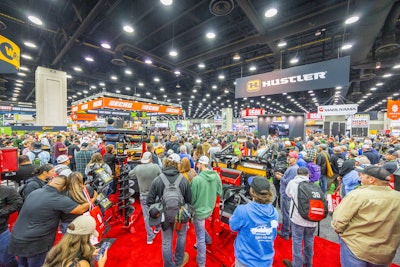
These days, the landscape industry is evolving constantly—a trait that's especially evident at industry trade shows such as Equip Expo—but one thing remains the same: Manufacturers are striving to create equipment to make landscape pros' lives easier.
We spoke with product managers at Equip Expo, and they let us in on the top challenges manufacturers in the green industry are aiming to alleviate for landscape professionals.
1. Labor
Almost every product expert Green Industry Pros encountered said filling the labor gap is a huge burden for their landscape contractor customers.
To help with this, manufacturers have developed machines that allow them to do similar amounts of work in less time and also lessen machines' maintenance requirements.
For example, John Deere has put this into action by expanding mower deck sizes and using technology such as oil guards on its machines to extend maintenance intervals, said Greg Moyer, product manager for Z9 at John Deere.
2. Upping productivity
Going hand in hand with labor, landscape companies strive to make the crews they do have as productive as possible.
"We're all professionals, but the universal currency is time," said Spencer Beckwith, product specialist at Bobcat Co. "The more you can do with less, the more money you can offer (your employees)."
This is also where autonomous equipment can come into play.
For example, if a landscape company integrates a robotic mower into their fleet, the crew member that would have been mowing can focus on detail work such as trimming or blowing.
"The analogy I like is if you paint a room, someone has to do the details and put the initial trim in, but then someone comes along with a roller. (The autonomous mower) is the roller," said Charles Brian Quinn, co-founder of Greenzie. "What's so nice is that is we're seeing people nearly doubling productivity, which means landscape companies can start bidding more jobs and generate more revenue."
Kevin Caleca, commercial robotics and digital product manager for Husqvarna, added that landscapers can look at robotics as just another tool in their belt.
"Some people look at robotics and think it's replacing them, but it's not going to replace a string trimmer or edger," Caleca said. "There are a lot of little things you still need your crew to do. It's just that this machine is cutting for you, and now you stand out against your competition."
3. Increasing efficiency
To become more efficient in their everyday operations, many companies have implemented software and technology to get them there.
For example, some manufacturers have implemented tracking technology into their machines.
"Having data pulled from a machine is more than just the tracking perspective. It's understanding that data and how they can use it to do something different, especially around idle time," said Amanda Andruth, go-to-market manager for technology for John Deere. "Then, from a maintenance perspective, the operators don't have to tell you how many hours the machine has run. You can see that and make decisions from there."
Other technology integration happens on the back end of the business, such as business management software.
"A lot of businesses talk about how organizing everything is a big challenge for a lot of people," said Julia Starostecki, account executive at Jobber. "Some people still use pen and paper. We provide a lot of ongoing support training and equip everyone to be set up already when they get started."
4. Minimizing downtime
If a machine is down, that means the landscape pros is not making money.
"When machines go down, they're out, so every day, we're making sure our machines are durable and we have the parts," said Brodie Milne, CMO of Yakta. "We make sure our partners are going to stand behind what we stand for as well stand behind the end users, especially commercial guys, because they're the ones putting a lot of hours on the machines."
David Finleyson, B2B public relations manager, Michelin, noted that Michelin's main goal of the Tweel tires is to keep people moving and keep equipment running.
"Productivity and uptime are the selling points of Tweel," Finleyson said. "The key point is that when you're mowing and you have a flat tire, your crew is down and you're not finishing the job, you're not moving on to the next jobsite, and you might have to wait for someone to come fix the flat or replace the tire."
5. Power concerns
Gas can be a large expense for landscape companies, so some manufacturers have put in effort to make their equipment's engines run more efficiently, such as an engine control unit, which will feed useful information to landscape fleet managers.
"Fuel efficiencies help cut down on the emissions, but just as importantly, it helps the professional landscaping contractors take that money and put it back into their business," Moyer said.
For companies interested in battery-powered equipment, a wide variety of manufacturers have that covered as well.
"(With electric equipment), you don't have to worry about someone contaminating the fuel. You just have to remember to plug it in like your cellphone to make it go to work the next day," said Jeff Jacobsmeyer, regional business manager for the central Midwest division of Takeuchi.
6. Better asset utilization
Because jobsites are becoming smaller, landscape pros need to be able to go into those spaces with machines and do a lot of things, said Trevor Chase, senior product specialist at Caterpillar.
"Contractors want us to make the machines so they don't have six different machines on the jobsite to perform specific tasks," Chase said. "They want one or two machines they can do most of their work with."
Attachments used with compact equipment can also assist with the challenge of making machines more versatile, said Jacobsmeyer.
"As a contractor, you're selling the job, what you can get done as a contractor and where you can make money," Jacobsmeyer said. "We've got attachments, and I see a lot of guys putting things together and seeing where they can make money."
Another benefit of smaller equipment, according to Sam Dando, senior product marketing manager with Toro and Siteworks, is that they're much easier to move around.
"Think of the bigger machines: They've gotten so expensive," Dando said. "For a lesser price, you can have a smaller truck and trailer, and the machines are more cost effective and versatile."


![Doosan Bobcat Wacker Neuson Stack 2ec Js Pb V6e[1]](https://img.greenindustrypros.com/mindful/acbm/workspaces/default/uploads/2025/12/doosan-bobcat-wacker-neuson-stack2ecjspbv6e1.CPyyz8ubHn.png?auto=format%2Ccompress&bg=fff&fill-color=fff&fit=fill&h=100&q=70&w=100)








![Doosan Bobcat Wacker Neuson Stack 2ec Js Pb V6e[1]](https://img.greenindustrypros.com/mindful/acbm/workspaces/default/uploads/2025/12/doosan-bobcat-wacker-neuson-stack2ecjspbv6e1.CPyyz8ubHn.png?ar=16%3A9&auto=format%2Ccompress&bg=fff&fill-color=fff&fit=fill&h=135&q=70&w=240)








